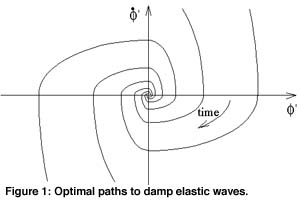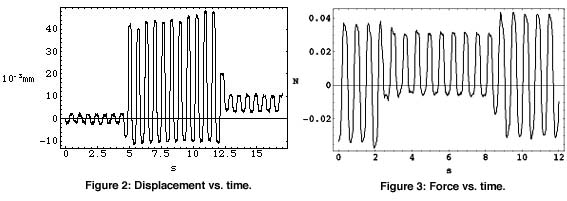Control Theory and Electro-elasticity: Realisation of an Active Damper
by Maurizio Brocato
Interaction between mechanics and electronics is paramount in
the design of sensors and actuators. At IEI-CNR, a system based
on the electrorheologic properties of a colloidal suspension,
capable of damping mechanical vibrations of small amplitude has
been conceived and developed.
Sensors and actuators are often developed using materials with
particular electromechanical properties; their modelling as continua
with microstructure differs from ordinary cases because of the
possibility of controlling, at least in part, their microstructure.
The design and optimisation of such devices utilises the mathematical
theory of distributed controls. We deal with a problem of this
type, but the case at issue differs from those prevalently analysed
in the literature (mainly after the work of J. L. Lions) as some
of the mechanical constitutive parameters may be altered, within
limits, at will.
In a previous paper the author suggested an application of Pontryagin’s
Maximum Principle to find optimal control paths for such ‘controllable’
materials. The example of how mechanical waves can be damped,
within given optimality requirements, in a body of which the elastic
response can be controlled was given. The optimal path to be followed
in order to minimise the kinetic energy in the shortest time,
is of the type shown in Figure 1 on a deformation vs. rate of
deformation plane: the body has to be as stiff as possible when
its kinetic energy transforms into an elastic one, and as soft
as possible under the opposite circumstances. Energy is thus dissipated
due to the discontinuities of the elastic
behaviour in time.

To implement this control strategy and build an active device capable of damping vibrations, we need a fit actuator: a material with elastic modulus that can be controlled and modified sufficiently quickly to switch from its softest to its stiffest configuration four times during each period of the unwanted oscillation. Electrorheologic (ER) materials meet these requirements.
ER materials are colloidal suspensions of dielectric particles
in a dielectric fluid, characterised by the Winslow effect. Applying
an electric field, the suspension aggregates in columns orthogonal
to the equipotential surfaces of the field. This phenomenon is
primarily due to charges that accumulate at the interface between
fluid and particles causing the latter to behave like dipoles.
Thus, acting on the electric field, the microstructure of the
mixture and therefore its gross mechanical properties can be modified.
The mathematical model of such a sudden change of phase is particularly
interesting and will be studied in the near future.
The particles’ organisation in columns is reversible and ruled
by a threshold of the electric field (a characteristic of the
particular material employed, which, typically, ranges from 2
to 3 MV/m) above which it cannot be observed. The time needed
for the organisation or its decomposition is in the order of 1
ms.
This effect is well known since Winslow’s work in 1949. We focus
on a particular aspect of it which, so far, has been given little
attention in applications: it gives the mixture – considered as
a (perhaps composite) continuum - the typical behaviour of a Bingham
body. When the suspension is organised in columns, applying a
small mechanical force, the system reacts as a linear elastic
solid, ie with a small displacement proportional to that force.
This can be explained by the fact that the columns are neither
destroyed nor rearranged during this process: they shear and bend
as if they were very many small beams within the fluid matrix
(of which the dynamic influence is probably negligible for such
small displacements).
In our experimental set up, two conducting cylinders are free
to move one into the other only along their common axis; both
are in contact via a suspension of starch into silicon oil filling
the thin space in between them, but otherwise electrically separate.
When a relatively small motion occurs the sheared ER material
reacts elastically, provided there is a sufficient difference
of potential between the cylinders.
To realise the control algorithm, an LVDT (Linear Variable Differential
Transformer) sensor captures the relative displacement of the
cylinder and informs a computer of the current kinematic state.
Once converted in terms of the phase variables of Figure 1, this
information is sufficient to decide whether to switch on or off
the electric field and thus drive the process along the desired
path. The switch needed to interrupt about 2mA at 3kV in a few
ms has been implemented using a beam triode.

The plots in Figure 2 and Figure 3 show the effect on displacement
and force of two opposite steps (on/off/on) of the electric field.
Please contact:
Maurizio Brocato - IEI-CNR
Tel: +39 050 593 422
E-mail: brocato@iei.pi.cnr.it
